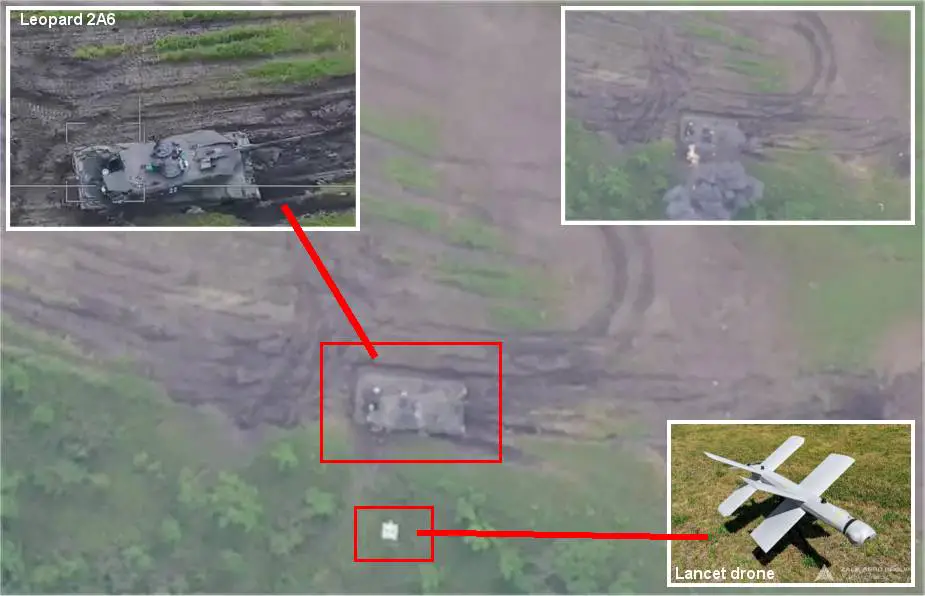- Army
- Conflicts in the world
- Israel - Iran conflict 2025
- Pakistan - India Conflict 2025
- Russia Ukraine War 2022
- Libya conflict day by day
- HAMAS - Israel War 2023
- Operation Serval in Mali French Army
- Sangaris operation Central African Republic
- Sangaris opération militaire République Centreafrique
- Ukraine - Russia conflict
- Syria conflict news
- Defence & Security Industry Technology
- Armies in the world
- Analysis Defense and Security Industry
- Conflicts in the world
- Navy
- Air
Russian Army escalates use of Lancet drones in Ukraine to prioritize destruction of Leopard 2 tanks
Russian forces in Ukraine are leveraging drone technology to counter the recent wave of counter-offensives launched by Ukrainian forces. This new tactic primarily targets the Leopard 2 tanks and other modern combat vehicles provided to Ukraine by European countries and the United States, which are now heavily used by the Ukrainian army in counter-operations against the Russian army. A video released on the social network Telegram on June 10, 2023, highlights this strategy, revealing the destruction of a Ukrainian Leopard 2A6 Main Battle Tank by a Russian Lancet loitering munition.
Follow Army Recognition on Google News at this link

Russian army uses Lancet loitering munition to destroy Leopard 2 tanks donated by allies to Ukraine. (Picture source video footage Telegram)
According to multiple sources published on Social Networks and the Internet, the Russian army has already claimed the destruction of two Leopard 2A6 and one Leopard 2A4 tanks, along with 13 Bradley M2A2 armored infantry fighting vehicles supplied by the United States, and three French AMX-10RC / RCR units.
This intensification in drone usage marks a shift in the Russian army's tactics. Their focus has been shifted to the neutralization of the modern armored units provided to Ukraine by allied forces. Given their enhanced capabilities, these assets pose a significant threat to Russian armored troops.
This drone strategy points to an effective asymmetrical response by the Russian forces. Using loitering munitions allows for precision strikes with a lower risk to personnel and equipment than traditional engagements.
However, it is worth noting that this strategy is not without its challenges. First, Russia will need to maintain a supply of drones capable of carrying out such attacks, especially given the rate at which they are being deployed. Second, the tactic's effectiveness might encourage Ukraine and its allies to invest more heavily in anti-drone measures, which could include jamming technology, anti-drone weaponry, or enhanced battlefield awareness tools.
From a strategic standpoint, Russia's decision to prioritize the destruction of high-end military hardware changes the dynamics of the conflict. By effectively neutralizing these key assets, Russia is not only seeking to reduce the immediate threat posed by these vehicles but also aiming to deter other nations from supplying Ukraine with similar high-end equipment.
This development serves as a stark reminder of the role emerging technologies like drones are playing in modern warfare. As the situation in Ukraine unfolds, the world will be watching closely to see how these tactics evolve and what impact they may have on the conflict's trajectory.
The Lancet loitering munition, developed by ZALA Aero, stands as a unique combat tool, often referred to as a 'suicide drone.' This unmanned combat aerial vehicle (UCAV) merges the functionalities of conventional missiles and drones, giving it the ability to be directed to a particular area where it can loiter, identify, and finally, upon locating a target, strike by self-detonating its payload, thereby annihilating itself along with the target.
The Lancet boasts a set of features that enhance its battlefield efficacy. Its compactness and lightweight design enhance transportability and ease of deployment. Furthermore, the Lancet has a substantial flight time, allowing for sustained operations, which can prove crucial during extended conflicts. Its range is equally noteworthy, providing it the ability to cover substantial distances and offer considerable tactical advantages.
With a speed range of 80 to 110 km/h, the drone offers an impressive endurance of up to 40 minutes. The Lancet-3 is designed with a maximum gross takeoff weight of 12 kg and can accommodate a payload weighing up to 3 kg. Its guidance system features optical-electronic and TV units, enabling control over the munition during the terminal stage of flight. This drone can be equipped with either high explosive (HE) or HE-fragmentation warheads, enhancing its versatility on the battlefield.


























